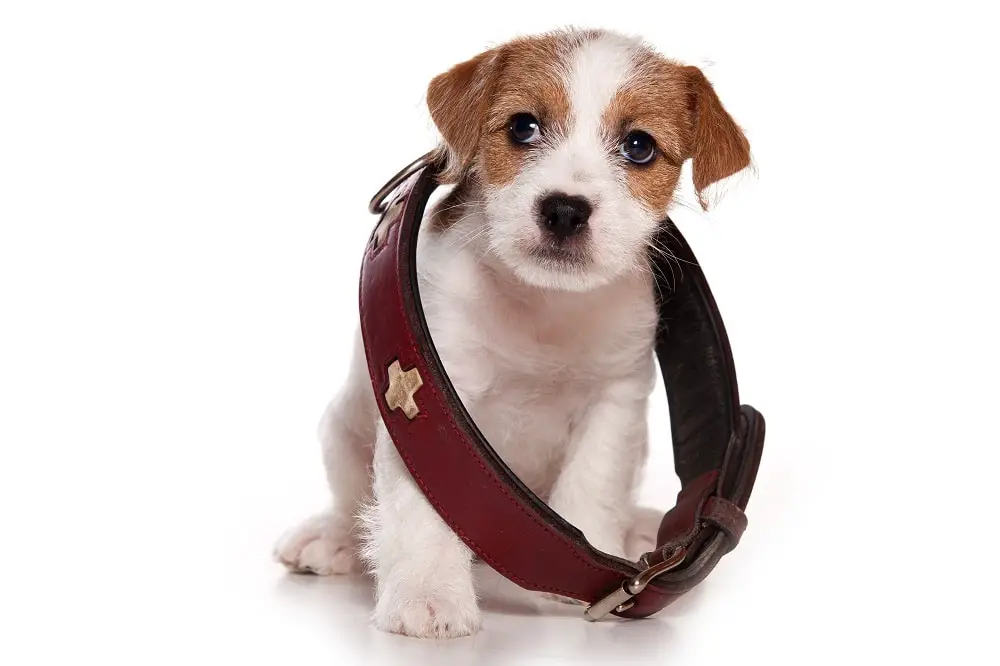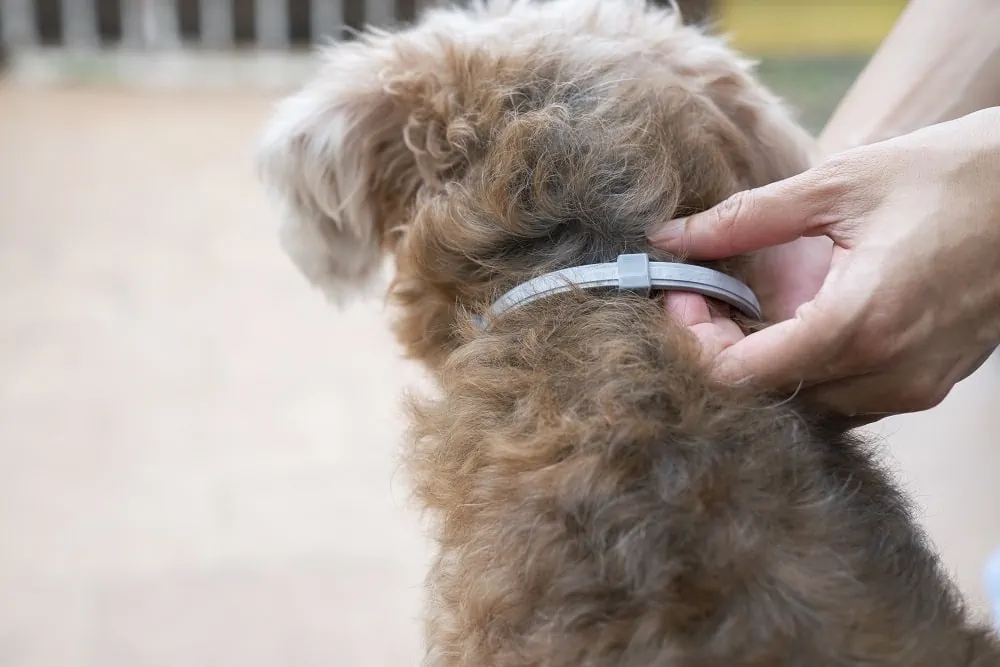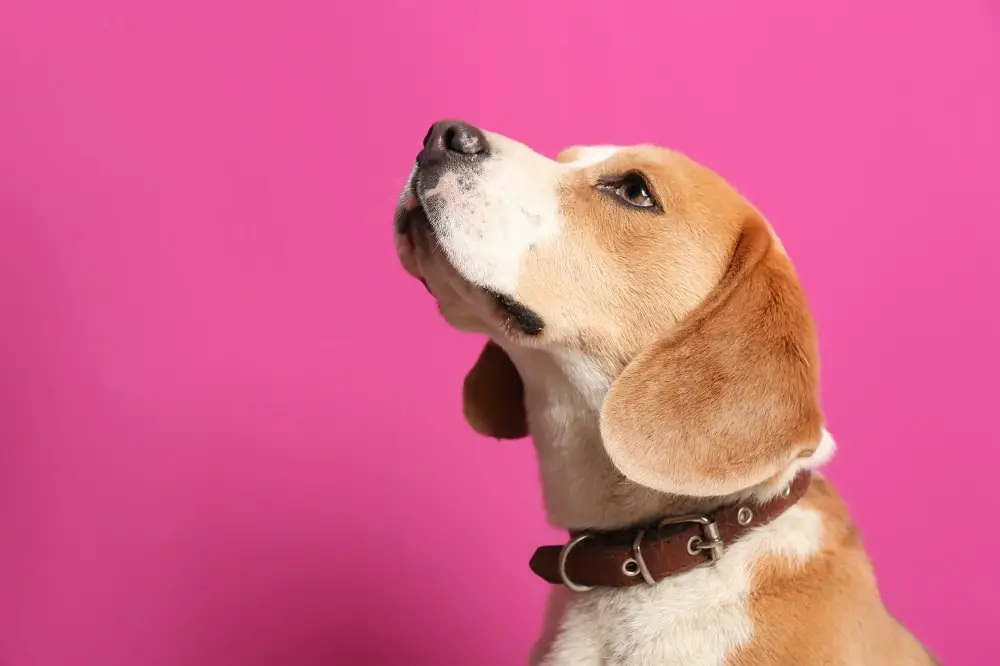Every new dog parent wants their new baby to be happy and healthy, and the collar is one item that marks their place as a member of the family. But, it’s important to ask: How tight should a dog collar be?
Your dog’s collar should not be so loose that they can slip out of it, but it should not be so tight that they have difficulty breathing. The proper position is high up on their neck behind the ears. Put two fingers in between the collar and their neck. Can you fit two fingers underneath the collar? If so, your dog collar has the proper fit.
Proper sizing can play a vital role in their health and safety, but how can you know if you have a proper fit? Just what is the recommended spacing between a dog’s collar and neck?
Different Types of Collars
There are many different types of collars made, and it can be difficult to choose the right one. Here is a list of the six most popular types of collars so you can find which one works best for you (source):
- Regular Flat
- Martingale
- Head Collar
- Dog harness
- Prong or Pinch Collar
- Slip Collar
The most common by far would be the regular flat collar with its simple plastic snap buckle, although they do come in leather with metal buckles as well. Regardless of the material, the most important rule to remember is the two-finger rule (source).
Importance of Properly Sized Collars

An improperly sized dog collar can injure a dog or, through extreme negligence, even lead to death. It is important to know what signs to look for.
Some signs that the collar is too tight would include trouble breathing, skin irritation, hair loss, a cut on the dog’s neck in the collar area, or an infection.
If a collar is too loose, they can slip out of it while on a simple walk, potentially putting others at risk. If your dog were to become spooked and flee, it could be difficult to regain control of them.
A well-trained and the more mature dog will be easier to handle, but a younger, less disciplined dog may pull more on the leash. It’s important to restrain your dog while they’re on the leash and prevent erratic behavior such as pulling or jumping.
In addition to having a properly fitting collar, it’s also important that your dog has the proper training not to place unnecessary strain on their collar and neck.
Adjusting a Collar
There are so many different types of collars to choose from, it may take some trial and error to find what works best for you. Let’s use an adjustable flat collar as our main example since this is the most commonly used.
Adjustable collars allow you to change the length of the collar by rearranging the straps. This allows you to accommodate your dog’s growth and allows them to be used for an extended amount of time.
This YouTube video provides a simple tutorial on how to change the length of an adjustable collar.
If you have a dog that wears a harness, one option would be to get an extender for the girth strap. Since harnesses tend to be more expensive than a typical collar, these harness extenders can save you from having to purchase a new harness.
You can find these at any pet store or any major websites such as Amazon or Etsy.
Spacing According to Life Stage
Depending on which breed of dog you have, they can grow a lot while transitioning from their puppy stage to full-grown adults. Some breeds can double or triple their birth weight in a year, making it important to keep an eye on their collar spacing and to adjust the collar as needed.
American Humane recommends checking a puppy’s collar at least once a week. If not properly adjusted, the collar can quickly become too tight, pressing into your dog’s skin and causing intense pain (source).
When a dog reaches their later stages in life, they can experience a dramatic loss in weight, causing their collar to become loose. Older dogs may need more support since they are more prone to limb injuries, so you may want to consider a dog harness instead of a collar.
What About When Seasons Change?
It’s important to keep an eye on your dog’s collar each season. Some dogs will grow much thicker coats during the winter, causing their collar to become tighter. In the summer and spring, dogs are known to shed, causing their collars to loosen.
How to Measure Your Dog’s Neck Size

A flexible tailor measuring tape, with measurements written on fabric, will be the easiest way to measure your dog’s neck. You should measure a few inches down from your dog’s head below the ears.
Pull the measuring tape snug but not tight. Remember the two-finger rule as you are doing this; you should be able to place two fingers in between the measuring tape and the dog’s neck.
Don’t Have a Tailor Measuring Tape?
Here is a simple way that you can measure your dog’s neck size. When you are ready to switch to a new collar and don’t have a tailor measuring tape, you can use an old collar and a standard measuring tape or a ruler.
In this case, you do not want to measure from end to end since you will end up at least an inch or two off. Instead, measure the fabric of the collar in between the male and female fasteners.
This will help you to gauge the proper collar size to get for your dog.
| Sizing Chart from Extra Small to Extra Large (source) | |||
| Size | Neck Measurement | Weight | Collar Widths |
| X-small | 7”-11” | 13-14 lbs | ⅝” |
| Small | 10”-14” | 14-45 lbs | ⅝-1” |
| Medium | 13”-18” | 14-65 lbs | 1-1.5” |
| Large | 15”-20” | 60-95 lbs | 1-1.5” |
| X-large | 18”-26” | 90-180 lbs | 1-1.5” |
How Often Should You Change Your Dog’s Collar?

Just like our favorite t-shirt will develop wear and tear from regular use, so will a dog collar. Nothing lasts forever and, if not maintained, collars can wear down quickly.
There are four signs that you should change out your dog’s collars for a new one.
1: Visible Wear and Tear
Damage in the form of frayed or cracked material from overuse or weather is very common with collars. A good way to limit this wear and tear is to rotate between more than one collar every week.
This has the added benefit of giving their skin a chance to breathe. Make sure that this becomes part of your weekly routine.
2: It’s Been Adjusted to the Max
Perhaps the most obvious sign that it’s time to change the dog’s collar is if you have adjusted the collar as far as it will go. If it’s still tight around the dog’s neck, it is time for a new one.
3: Prolonged Exposure to Water and/or Mud
Common materials used for collar include leather and various fabrics. Both can absorb large amounts of water and mud. Leather, in particular, can suffer water damage after long periods of exposure as it tends to stiffen.
Over time, this can wear down the collar, so it’s better to take the collar off so it can be cleaned and dried properly. If a collar has been allowed to cake with mud over time, or the leather has become very rigid, it’s probably time to get a new collar.
4: The Collar Causes Skin Irritation
Some dogs will have allergies to certain materials too. Maybe your dog has developed a rash, a constant itch, or is chafing. This is a good indicator that it is time to look for a new collar made of a different material. Nylon is a common allergen for dogs.
Should you keep the collar on 24/7?
A great way to keep track of how your dog’s collar is fitting properly is to remove the collar at night. Make sure they are in an enclosed space in your home or outside where they cannot get loose.
Doing this task every night will not only allow your dog’s neck to breathe, but it will also get you in the habit of checking their neck and the collar’s fit every morning when you put it back on. This is also a perfect opportunity to look to see if they have any raw spots around the neck area.
Final Thoughts
It is important to keep track of how your dog’s collar fits as they continue to grow. This will prevent injury to your companion while ensuring that they remain happy and healthy. Remember the two-finger rule and make sure they don’t have difficulty breathing.
Having the right size collar helps to ensure that you have better control of your dog on the leash when you’re out in public. Just make sure to check your dog’s neck regularly for any cuts, infections, or signs of irritation.
If you do, you may want to consult your vet to see what changes you can make to ensure the health of your pet.


0 Comments